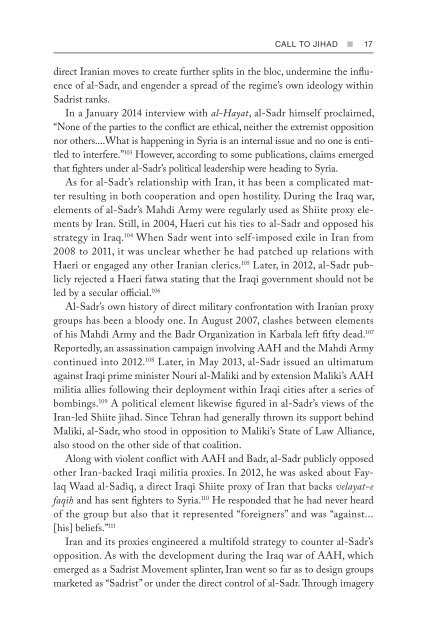Create successful ePaper yourself
Turn your PDF publications into a flip-book with our unique Google optimized e-Paper software.
CALL TO <strong>JIHAD</strong> n 17<br />
direct Iranian moves to create further splits in the bloc, undermine the influence<br />
of al-Sadr, and engender a spread of the regime’s own ideology within<br />
Sadrist ranks.<br />
In a January 2014 interview with al-Hayat, al-Sadr himself proclaimed,<br />
“None of the parties to the conflict are ethical, neither the extremist opposition<br />
nor others....What is happening in Syria is an internal issue and no one is entitled<br />
to interfere.” 103 However, according to some publications, claims emerged<br />
that fighters under al-Sadr’s political leadership were heading to Syria.<br />
As for al-Sadr’s relationship with Iran, it has been a complicated matter<br />
resulting in both cooperation and open hostility. During the Iraq war,<br />
elements of al-Sadr’s Mahdi Army were regularly used as Shiite proxy elements<br />
by Iran. Still, in 2004, Haeri cut his ties to al-Sadr and opposed his<br />
strategy in Iraq. 104 When Sadr went into self-imposed exile in Iran from<br />
2008 to 2011, it was unclear whether he had patched up relations with<br />
Haeri or engaged any other Iranian clerics. 105 Later, in 2012, al-Sadr publicly<br />
rejected a Haeri fatwa stating that the Iraqi government should not be<br />
led by a secular official. 106<br />
Al-Sadr’s own history of direct military confrontation with Iranian proxy<br />
groups has been a bloody one. In August 2007, clashes between elements<br />
of his Mahdi Army and the Badr Organization in Karbala left fifty dead. 107<br />
Reportedly, an assassination campaign involving AAH and the Mahdi Army<br />
continued into 2012. 108 Later, in May 2013, al-Sadr issued an ultimatum<br />
against Iraqi prime minister Nouri al-Maliki and by extension Maliki’s AAH<br />
militia allies following their deployment within Iraqi cities after a series of<br />
bombings. 109 A political element likewise figured in al-Sadr’s views of the<br />
Iran-led Shiite jihad. Since Tehran had generally thrown its support behind<br />
Maliki, al-Sadr, who stood in opposition to Maliki’s State of Law Alliance,<br />
also stood on the other side of that coalition.<br />
Along with violent conflict with AAH and Badr, al-Sadr publicly opposed<br />
other Iran-backed Iraqi militia proxies. In 2012, he was asked about Faylaq<br />
Waad al-Sadiq, a direct Iraqi Shiite proxy of Iran that backs velayat-e<br />
faqih and has sent fighters to Syria. 110 He responded that he had never heard<br />
of the group but also that it represented “foreigners” and was “against...<br />
[his] beliefs.” 111<br />
Iran and its proxies engineered a multifold strategy to counter al-Sadr’s<br />
opposition. As with the development during the Iraq war of AAH, which<br />
emerged as a Sadrist Movement splinter, Iran went so far as to design groups<br />
marketed as “Sadrist” or under the direct control of al-Sadr. Through imagery


